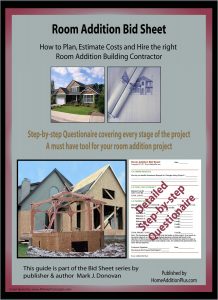Building a Home in Cold Weather Requires additional Planning and Some Unique Methods
By Mark J. Donovan
|
|
Cold weather home building offers its share of additional challenges when building a home or home addition. Of particular concern during a cold weather home construction project is the pouring of concrete.
If the right precautions are not taken, the foundation or concrete slab may not cure right and end up cracking in short order. Snow and ice conditions are also part of cold weather home building. |
Besides making a construction jobsite more dangerous snow and ice can damage building materials and dramatically slow the building progress.
Expect Delays when Building Home in Cold Weather
Cold weather home building also typically requires more time as schedule slips frequently occur.
If you’re planning a cold weather home building project it is important to think ahead on how you will deal with the unique problems that are associated with building in this type of weather.
Pouring Concrete Foundations in Cold Weather – Be Careful
First and foremost avoid pouring the concrete footings and foundation in extremely cold weather. Yes, it can be done with additives included in the concrete mix and the use of insulation blankets or hay, however it is always preferable to pour a foundation in warmer weather, preferably above 40 degrees Fahrenheit.
In regards to a concrete basement slab floor, hold off pouring it until the home is sealed up. This way you can ensure both a strong and smooth basement floor.
Cover Home Building Construction Materials and Tools
Another major concern with cold weather home building is caring for the construction materials.
Make sure to cover the lumber and other construction materials with tarps to prevent snow and ice from falling on them. Not only can snow and ice damage the material, it also makes it much more difficult to get access to.
Roofing in Cold Weather Presents Unique Problems
Installing asphalt shingles in cold weather can also be challenging. Asphalt shingles can easily crack in cold weather and the adhesive on the back of them is not as sticky compared to when installing them in warmer temperatures.
As a result, even if they are installed properly the shingles are more susceptible to wind damage until the roof shingles have had a chance to warm up and the adhesive soften.
Button Up Home ASAP
Once the home has been buttoned up with walls, roofs, doors, windows, and shingles installed, plan on heating the home or home addition with propane or kerosene heaters. By doing so you’ll help make a better environment for your inside subcontractors, such as plumbers, electricians, insulation installers and drywallers to work in.
|
Not to mention, taping and mudding drywall requires above freezing temperatures to ensure proper curing. Keep up with Snow Removal Also plan ahead for snow removal. The last thing you want is subcontractors and delivery vehicles turning away from your project due to the fact that they can’t drive into the driveway. |
|
Make sure the driveway is plowed before sunrise since most subcontractors arrive on a jobsite very early.
Finally, recognize the fact that with cold weather home building delays will happen. Plan for them when developing your schedules and have contingency back up plans.
Want to Build Your Own Home, see HomeAdditionPlus.com’s Home Addition Bid Sheets. Our Home Addition Bid Sheets provide you with the knowledge and information on how to plan a home building project, and what to look for when hiring contractors. They also include detailed cost breakdown tables and spreadsheets for estimating your own new home construction building costs.
Free Home Addition Price Quotes with No Obligation!
Fill out our 3-5 minute quick and easy form, and receive a free price quote on a house addition from one of our prescreened and licensed home addition contractors. This process is free and there is no obligation to continue once you receive your home addition price estimate.



